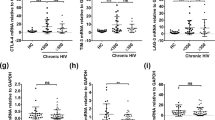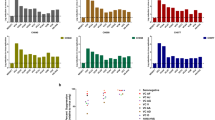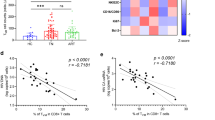Abstract
γδ T cells play important roles in innate immunity as the first-line of defense against infectious diseases. Human immunodeficiency virus (HIV) infection disrupts the balance between Vδ1 T cells and Vδ2 T cells and causes dysfunction among γδ T cells. However, the biological mechanisms and clinical consequences of this disruption require further investigation. In this study, we performed a comprehensive analysis of phenotype and function of memory γδ T cells in cohorts of Chinese individuals with HIV infection. We found a dynamic change in memory Vδ2 γδ T cells, skewed toward an activated and terminally differentiated effector memory phenotype TEMRA Vδ2 γδ T cell, which may account for the dysfunction of Vδ2 γδ T cells in HIV disease. In addition, we found that IL-17-producing γδ T cells were significantly increased in HIV-infected patients with fast disease progression and positively correlated with HLA-DR+ γδ T cells and CD38+HLA-DR+ γδ T cells. This suggests the IL-17 signaling pathway is involved in γδ T-cell activation and HIV pathogenesis. Our findings provide novel insights into the role of Vδ2 T cells during HIV pathogenesis and represent a sound basis on which to consider immune therapies with these cells.
This is a preview of subscription content, access via your institution
Access options
Subscribe to this journal
Receive 12 digital issues and online access to articles
$119.00 per year
only $9.92 per issue
Buy this article
- Purchase on Springer Link
- Instant access to full article PDF
Prices may be subject to local taxes which are calculated during checkout






Similar content being viewed by others
References
Hayday AC . Gammadelta T cells and the lymphoid stress–surveillance response. Immunity 2009; 31: 184–196.
Poccia F, Agrati C, Ippolito G, Colizzi V, Malkovsky M . Natural T cell immunity to intracellular pathogens and nonpeptidic immunoregulatory drugs. Curr Mol Med 2001; 1: 137–151.
Bonneville M, O'Brien RL, Born WK . Gammadelta T cell effector functions: a blend of innate programming and acquired plasticity. Nat Rev Immunol 2010; 10: 467–478.
Schild H, Mavaddat N, Litzenberger C, Ehrich EW, Davis MM, Bluestone JA et al. The nature of major histocompatibility complex recognition by gamma delta T cells. Cell 1994; 76: 29–37.
Kong Y, Cao W, Xi X, Ma C, Cui L, He W . The NKG2D ligand ULBP4 binds to TCRgamma9/delta2 and induces cytotoxicity to tumor cells through both TCRgammadelta and NKG2D. Blood 2009; 114: 310–317.
Qi J, Zhang J, Zhang S, Cui L, He W . Immobilized MICA could expand human Vdelta1 gammadelta T cells in vitro that displayed major histocompatibility complex class I chain-related A-dependent cytotoxicity to human epithelial carcinomas. Scand J Immunol 2003; 58: 211–220.
Bukowski JF, Morita CT, Brenner MB . Human gamma delta T cells recognize alkylamines derived from microbes, edible plants, and tea: implications for innate immunity. Immunity 1999; 11: 57–65.
Tanaka Y, Morita CT, Tanaka Y, Nieves E, Brenner MB, Bloom BR . Natural and synthetic non-peptide antigens recognized by human gamma delta T cells. Nature 1995; 375: 155–158.
Constant P, Davodeau F, Peyrat MA, Poquet Y, Puzo G, Bonneville M et al. Stimulation of human gamma delta T cells by nonpeptidic mycobacterial ligands. Science 1994; 264: 267–270.
De Paoli P, Gennari D, Martelli P, Basaglia G, Crovatto M, Battistin S et al. A subset of gamma delta lymphocytes is increased during HIV-1 infection. Clin Exp Immunol 1991; 83: 187–191.
Autran B, Triebel F, Katlama C, Rozenbaum W, Hercend T, Debre P . T cell receptor gamma/delta+ lymphocyte subsets during HIV infection. Clin Exp Immunol 1989; 75: 206–210.
Zheng NN, McElrath MJ, Sow PS, Mesher A, Hawes SE, Stern J et al. Association between peripheral gammadelta T-cell profile and disease progression in individuals infected with HIV-1 or HIV-2 in West Africa. J Acquir Immune Defic Syndr 2011; 57: 92–100.
Poccia F, Boullier S, Lecoeur H, Cochet M, Poquet Y, Colizzi V et al. Peripheral V gamma 9/V delta 2 T cell deletion and anergy to nonpeptidic mycobacterial antigens in asymptomatic HIV-1-infected persons. J Immunol 1996; 157: 449–461.
Li H, Peng H, Ma P, Ruan Y, Su B, Ding X et al. Association between Vgamma2Vdelta2 T cells and disease progression after infection with closely related strains of HIV in China. Clin Infect Dis 2008; 46: 1466–1472.
Enders PJ, Yin C, Martini F, Evans PS, Propp N, Poccia F et al. HIV-mediated gammadelta T cell depletion is specific for Vgamma2+ cells expressing the Jgamma1.2 segment. AIDS Res Hum Retroviruses 2003; 19: 21–29.
Li H, Chaudhry S, Poonia B, Shao Y, Pauza CD . Depletion and dysfunction of Vgamma2Vdelta2 T cells in HIV disease: mechanisms, impacts and therapeutic implications. Cell Mol Immunol 2013; 10: 42–49.
Jansen CA, de Cuyper IM, Steingrover R, Jurriaans S, Sankatsing SU, Prins JM et al. Analysis of the effect of highly active antiretroviral therapy during acute HIV-1 infection on HIV-specific CD4 T cell functions. AIDS 2005; 19: 1145–1154.
Harari A, Petitpierre S, Vallelian F, Pantaleo G . Skewed representation of functionally distinct populations of virus-specific CD4 T cells in HIV-1-infected subjects with progressive disease: changes after antiretroviral therapy. Blood 2004; 103: 966–972.
Champagne P, Ogg GS, King AS, Knabenhans C, Ellefsen K, Nobile M et al. Skewed maturation of memory HIV-specific CD8 T lymphocytes. Nature 2001; 410: 106–111.
Huang X, Lodi S, Fox Z, Li W, Phillips A, Porter K et al. Rate of CD4 decline and HIV-RNA change following HIV seroconversion in men who have sex with men: a comparison between the Beijing PRIMO and CASCADE cohorts. J Acquir Immune Defic Syndr 2013; 62: 441–446.
Huang X, Chen H, Li W, Li H, Jin X, Perelson AS et al. Precise determination of time to reach viral load set point after acute HIV-1 infection. J Acquir Immune Defic Syndr 2012; 61: 448–454.
Hubert JB, Burgard M, Dussaix E, Tamalet C, Deveau C, Le Chenadec J et al. Natural history of serum HIV-1 RNA levels in 330 patients with a known date of infection. The SEROCO Study Group. AIDS 2000; 14: 123–131.
Mahnke YD, Song K, Sauer MM, Nason MC, Giret MT, Carvalho KI et al. Early immunologic and virologic predictors of clinical HIV-1 disease progression. AIDS 2013; 27: 697–706.
Zhou J, Kang N, Cui L, Ba D, He W . Anti-gammadelta TCR antibody-expanded gammadelta T cells: a better choice for the adoptive immunotherapy of lymphoid malignancies. Cell Mol Immunol 2012; 9: 34–44.
Kang N, Zhou J, Zhang T, Wang L, Lu F, Cui Y et al. Adoptive immunotherapy of lung cancer with immobilized anti-TCRgammadelta antibody-expanded human gammadelta T-cells in peripheral blood. Cancer Biol Ther 2009; 8: 1540–1549.
Baroncelli S, Galluzzo CM, Pirillo MF, Mancini MG, Weimer LE, Andreotti M et al. Microbial translocation is associated with residual viral replication in HAART-treated HIV+ subjects with <50 copies/ml HIV-1 RNA. J Clin Virol 2009; 46: 367–370.
Brenchley JM, Price DA, Schacker TW, Asher TE, Silvestri G, Rao S et al. Microbial translocation is a cause of systemic immune activation in chronic HIV infection. Nat Med 2006; 12: 1365–1371.
Hazenberg MD, Stuart JW, Otto SA, Borleffs JC, Boucher CA, de Boer RJ et al. T-cell division in human immunodeficiency virus (HIV)-1 infection is mainly due to immune activation: a longitudinal analysis in patients before and during highly active antiretroviral therapy (HAART). Blood 2000; 95: 249–255.
Hazenberg MD, Otto SA, van Benthem BH, Roos MT, Coutinho RA, Lange JM et al. Persistent immune activation in HIV-1 infection is associated with progression to AIDS. AIDS 2003; 17: 1881–1888.
Rajasuriar R, Khoury G, Kamarulzaman A, French MA, Cameron PU, Lewin SR . Persistent immune activation in chronic HIV infection: do any interventions work? AIDS 2013; 27: 1199–1208.
Klatt NR, Funderburg NT, Brenchley JM . Microbial translocation, immune activation, and HIV disease. Trends Microbiol 2013; 21: 6–13.
Wallet MA, Rodriguez CA, Yin L, Saporta S, Chinratanapisit S, Hou W et al. Microbial translocation induces persistent macrophage activation unrelated to HIV-1 levels or T-cell activation following therapy. AIDS 2010; 24: 1281–1290.
Cassol E, Malfeld S, Mahasha P, van der Merwe S, Cassol S, Seebregts C et al. Persistent microbial translocation and immune activation in HIV-1-infected South Africans receiving combination antiretroviral therapy. J Infect Dis 2010; 202: 723–733.
Brenchley JM, Price DA, Douek DC . HIV disease: fallout from a mucosal catastrophe? Nat Immunol 2006; 7: 235–239.
Schulz SM, Kohler G, Holscher C, Iwakura Y, Alber G . IL-17A is produced by Th17, gammadelta T cells and other CD4- lymphocytes during infection with Salmonella enterica serovar Enteritidis and has a mild effect in bacterial clearance. Int Immunol 2008; 20: 1129–1138.
Nakayama K, Nakamura H, Koga M, Koibuchi T, Fujii T, Miura T et al. Imbalanced production of cytokines by T cells associates with the activation/exhaustion status of memory T cells in chronic HIV type 1 infection. AIDS Res Hum Retroviruses 2012; 28: 702–714.
Hebbeler AM, Propp N, Cairo C, Li H, Cummings JS, Jacobson LP et al. Failure to restore the Vgamma2-Jgamma1.2 repertoire in HIV-infected men receiving highly active antiretroviral therapy (HAART). Clin Immunol 2008; 128: 349–357.
Chaudhry S, Cairo C, Venturi V, Pauza CD . The gammadelta T-cell receptor repertoire is reconstituted in HIV patients after prolonged antiretroviral therapy. AIDS 2013; 27: 1557–1562.
Li H, Pauza CD . Critical roles for Akt kinase in controlling HIV envelope-mediated depletion of CD4 T cells. Retrovirology 2013; 10: 60.
Herbeuval JP, Grivel JC, Boasso A, Hardy AW, Chougnet C, Dolan MJ et al. CD4+ T-cell death induced by infectious and noninfectious HIV-1: role of type 1 interferon-dependent, TRAIL/DR5-mediated apoptosis. Blood 2005; 106: 3524–3531.
Boudova S, Li H, Sajadi MM, Redfield RR, Pauza CD . Impact of persistent HIV replication on CD4 negative Vgamma2Vdelta2 T cells. J Infect Dis 2012; 205: 1448–1455.
Miedema F, Hazenberg MD, Tesselaar K, van Baarle D, de Boer RJ, Borghans JA . Immune activation and collateral damage in AIDS pathogenesis. Front Immunol 2013; 4: 298.
Sodora DL, Silvestri G . Immune activation and AIDS pathogenesis. AIDS 2008; 22: 439–446.
Ferrarini M, Delfanti F, Gianolini M, Rizzi C, Alfano M, Lazzarin A et al. NF-kappa B modulates sensitivity to apoptosis, proinflammatory and migratory potential in short- versus long-term cultured human gamma delta lymphocytes. J Immunol 2008; 181: 5857–5864.
Sandler NG, Wand H, Roque A, Law M, Nason MC, Nixon DE et al. Plasma levels of soluble CD14 independently predict mortality in HIV infection. J Infect Dis 2011; 203: 780–790.
Ipp H, Zemlin AE, Glashoff RH, van Wyk J, Vanker N, Reid T et al. Serum adenosine deaminase and total immunoglobulin G correlate with markers of immune activation and inversely with CD4 counts in asymptomatic, treatment-naive HIV infection. J Clin Immunol 2013; 33: 605–612.
Hamada S, Umemura M, Shiono T, Tanaka K, Yahagi A, Begum MD et al. IL-17A produced by gammadelta T cells plays a critical role in innate immunity against listeria monocytogenes infection in the liver. J Immunol 2008; 181: 3456–3463.
Chen M, Hu P, Peng H, Zeng W, Shi X, Lei Y et al. Enhanced peripheral gammadeltaT cells cytotoxicity potential in patients with HBV-associated acute-on-chronic liver failure might contribute to the disease progression. J Clin Immunol 2012; 32: 877–885.
Acknowledgements
This work was supported by the Mega-Projects of National Science Research for the 12th Five-Year Plan (2012ZX10001006), the Natural Science Foundation of China (30930083), the Ministry of Health (201302018) and the PUMC Scholarship for Dr Jianmin Zhang. We thank Dr Austin Cape for careful reading and comments.
Author information
Authors and Affiliations
Corresponding author
Ethics declarations
Competing interests
The authors have declared no conflicts of interest in this study.
Rights and permissions
About this article
Cite this article
Li, Z., Jiao, Y., Hu, Y. et al. Distortion of memory Vδ2 γδ T cells contributes to immune dysfunction in chronic HIV infection. Cell Mol Immunol 12, 604–614 (2015). https://doi.org/10.1038/cmi.2014.77
Received:
Revised:
Accepted:
Published:
Issue Date:
DOI: https://doi.org/10.1038/cmi.2014.77
Keywords
This article is cited by
-
γδ T cells: origin and fate, subsets, diseases and immunotherapy
Signal Transduction and Targeted Therapy (2023)
-
Synergistic effect of IL-12 and IL-18 induces TIM3 regulation of γδ T cell function and decreases the risk of clinical malaria in children living in Papua New Guinea
BMC Medicine (2017)



